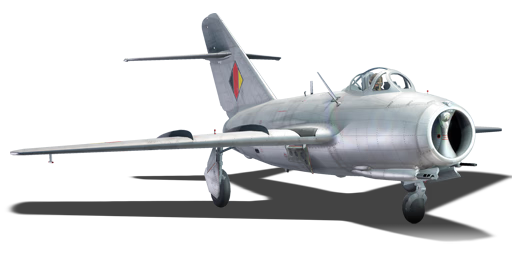




During the early '50s, a design proposal for an upgraded MiG-15, titled the MiG-15bis (second), was issued. The main upgrade was the new VK-1 engine, offering a lot more thrust. The East German air force would start receiving the upgraded MiG-15bis not long after it entered service with the USSR and proved itself there. The MiG-15bis would serve as the frontline fighter of the NVA, being later supplemented by the MiG-17 and its licensed copy, the Lim-5, before being ultimately replaced by proper 3rd generation fighters such as the MiG-21F in the late '60s and early '70s.
Introduced in Update 1.39, the MiG-15bis (Germany) is a German operated copy of the MiG-15bis and performs identically to it. Having the powerful VK-1 engine and strong firepower, the MiG-15bis shines with its overall performance against a majority of jets that it faces, though it still requires attention to enemy missiles and strong trigger discipline for the limited ammunition onboard. Alternatively, in full uptiers, it can form the backmarker of the team rather than the tip of the spear, picking off distracted targets and being able to fight back against even some supersonic jets in close-in dogfights.
flaps
flaps
flaps
brake
| Belt | Belt filling | Armor penetration (mm) at a distance: | |||||
|---|---|---|---|---|---|---|---|
| 10 m | 100 m | 500 m | 1000 m | 1500 m | 2000 m | ||
| HEFI-T/HEFI-T/API-T | 49 | 47 | 39 | 32 | 26 | 21 | |
| HEFI-T/HEF-I/HEF-I | 6 | 6 | 5 | 4 | 3 | 3 | |
| API-T | 49 | 47 | 39 | 32 | 26 | 21 | |
| Belt | Belt filling | Armor penetration (mm) at a distance: | |||||
|---|---|---|---|---|---|---|---|
| 10 m | 100 m | 500 m | 1000 m | 1500 m | 2000 m | ||
| AP-I/FI-T | 32 | 30 | 22 | 15 | 10 | 7 | |
| FI-T/AP-I/AP-I/AP-I | 32 | 30 | 22 | 15 | 10 | 7 | |
| FI-T/FI-T/FI-T/AP-I | 32 | 30 | 22 | 15 | 10 | 7 | |
| AP-I | 32 | 30 | 22 | 15 | 10 | 7 | |












Flight performance | |
|---|---|
Survivability |
|---|
Weaponry | ||
|---|---|---|